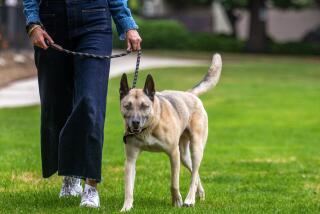New Drug Can Let Pooch Avoid Living a Dog’s Life
- Share via
WASHINGTON — The Food and Drug Administration said Tuesday that it has approved the first “antidepressant” drug designed exclusively for Fido.
The canine “uppers” help treat separation anxiety, which apparently can be a serious problem for some neurotic dogs whose humans tend to live at the office--or who just spend too many hours away from home.
This is sure to be welcome news for the millions of Americans who dote on their pooches in myriad ways. Dog lovers spend about $20 billion a year on products and services for their pets, lavishing them with--among other things--doggy gourmet food and baked goods, clothing and grooming and “pet-icures.”
Baby boomers, conscious of their own health, are proactive about their pets--exploring acupuncture, water therapy, vitamins and herbal medicines to ensure optimal health. Day spas for dogs sport treadmills, and therapeutic mattresses help aging dogs sleep.
Pet attorneys, limousines, dog psychics and psychotherapy are not uncommon. One anonymous couple even paid Texas A&M; University $2.3 million to clone their dog.
Now dogs will have their own designer drug to soothe free-floating anxieties.
The drug is Clomicalm, made by Novartis Animal Health of Greensboro, N.C. Its chemical name is clomipramine hydrochloride--the basic ingredient of several human antidepressants.
Laugh if you will, but to pet owners who have no choice about leaving their dogs alone and then return home to chaos and debris--not to mention neighbors furious about prolonged barking--it can be a serious matter.
“There are 55 million dogs in the United States, and as many as 10% of them have this problem to some degree,” said Dr. Nicholas Dodman, professor of clinical studies at Tufts University School of Veterinary Medicine. “It is serious in about 40% of these, and they are the ones who really could benefit from this drug.”
But don’t blame the dogs, experts say. They are only following what their instincts tell them to do.
Dogs are “pack” animals by nature and are quite social. Often their survival depends on continued “bonding” with the rest of the pack, even if the pack--in modern times--consists of a human family, according to animal behavioral experts.
“Being socially ostracized from the pack is like a death sentence,” said Dr. Stephen Sundlof, head of the FDA’s center for veterinary medicine, which long has been responsible for regulating drugs that are used in animals.
As a result, these dogs can become very naughty when separated from their humans--barking uncontrollably, chewing, clawing, urinating or otherwise destroying clothes, rugs, or furniture--behavior that typically is not seen when their owners are present.
“It’s not just a problem for owners and their neighbors, but it’s a terrible problem for the dog,” said Dodman, the author of “The Dog Who Loved Too Much.”
“Dogs suffer from the most extraordinary anxiety when they’re left, and owners can misinterpret the behavior and then punish the dog,” he added. “The dog’s behavior is not malicious; they are so attached, and so scared of being left alone that they go almost hysterical. It’s called ‘barrier frustration.’ Often they try to break out--and that’s why you’ll find damage around the window frame or the door.”
The problem accounts for up to 40% of visits to the vet, where behavior modification techniques are usually recommended. When those don’t work, owners sometimes become so desperate that they are forced to euthanize their pets.
“We had a lab mix who hated to be alone--she would bark like crazy when my wife and I left,” said Bob Scott, a graduate student at Clark University in Worcester, Mass., who is--of all things--studying animal behavior.
They worked on behavior modification techniques--taking short trips at first, then gradually lengthening them, rewarding her when she was good while they were away, and teaching her that when they returned they wouldn’t pay attention to her until she settled down.
“Our dog has finally gotten over it,” he said. “She’s not nearly as anxious as she was.”
It doesn’t matter what kind of dog, or size. The problem seems to stem from a troubled past--a bad early experience, such as coming from a “poorly run puppy mill” or pet store, or having had multiple previous owners, Dodman said.
Just as with human beings, the drug is supposed to be used in conjunction with behavioral modification therapy. Used alone, the drug won’t work, the FDA said.
Dogs do not really suffer human-like depression. It only looks that way. They do “act neurotic, show high levels of anxiety and destroy things, but we don’t have any indication that dogs suffer depression as we know it,” Sundlof said. “So this is more of an ‘anti-anxiety’ drug.”
It is unclear when the drug, which will be available only by vet prescription, will be for sale or how much it will cost. Dodman said it costs about $1 a pill; dogs require one or two pills daily, depending on their weight. The drug does not have to be taken forever; once the behavior improves, the dog can give up the drug.
More to Read
Sign up for Essential California
The most important California stories and recommendations in your inbox every morning.
You may occasionally receive promotional content from the Los Angeles Times.













